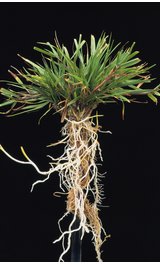Barking is a famous variety on golf greens! Both during summers and winters this bent grass shows up an exceptional greenness! Barking has superb shoot density and a close mowing tolerance down to 4 mm! This makes Barking the best choice for using on your greens!
Application
Barking is a Agrostis capillaris suitable for:
- Greens
- Golf tees
- Surrounds / aprons
- Bowling greens
- Ornamental lawns
Colour and leaf texture
Medium-light green coloured variety.
Partner varieties in mixtures
Barking has been extensively tested in trials at STRI UK and more local trials all around Europe. All trials showed the signifi cant ornamental value of Barking and its great performance on golf greens.
Best combinations were found with Festuca rubra spps. such as Barcrown, Viktorka and Barswing. Other combinations are with Agrostis capillaris Heriot.
Additional features



![Bar_Fescue[1]](https://dxgh891opzso3.cloudfront.net/files/5/0/3/5/Bar_Fescue%5b1%5d.jpg?height=370&width=880&mode=crop&converttowebp=0)
